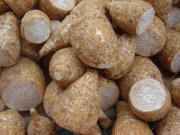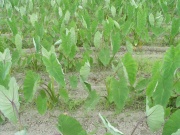Difference between revisions of "Taro flour"
Jump to navigation
Jump to search
(username removed) |
m (Text replace - "== Authority ==" to "== Sources Checked for Data in Record ==") |
||
| Line 17: | Line 17: | ||
Raw taro roots and leaves are poisonous; they must be cooked prior to eating. | Raw taro roots and leaves are poisonous; they must be cooked prior to eating. | ||
| − | == | + | == Sources Checked for Data in Record == |
* G.S.Brady, ''Materials Handbook'', McGraw-Hill Book Co., New York, 1971 Comment: p. 633 | * G.S.Brady, ''Materials Handbook'', McGraw-Hill Book Co., New York, 1971 Comment: p. 633 | ||
Revision as of 17:57, 1 May 2016
Description
A white, edible powder made from the crushed root of the Colocasia esculenta plant that is native to Asia and the Pacific Islands. Taro flour is used to make a starchy paste called poi. The starchy mixture has also been used as an adhesive.
Synonyms and Related Terms
Colocasia esculenta; harina de taro (Esp.); cocoyam; dasheen; eddo; juau; poi
Hazards and Safety
Raw taro roots and leaves are poisonous; they must be cooked prior to eating.
Sources Checked for Data in Record
- G.S.Brady, Materials Handbook, McGraw-Hill Book Co., New York, 1971 Comment: p. 633
- Random House, Webster's Encyclopedic Unabridged Dictionary of the English Language, Grammercy Book, New York, 1997
- The American Heritage Dictionary or Encarta, via Microsoft Bookshelf 98, Microsoft Corp., 1998
- Encyclopedia Britannica, http://www.britannica.com Comment: "taro" Encyclopædia Britannica Premium Service. [Accessed 28 Sept. 2005].
- Wikipedia, the free encyclopedia, at http://www.wikipedia.com Comment: http://en.wikipedia.org/wiki/Taro (Accessed Sept. 28, 2005)

